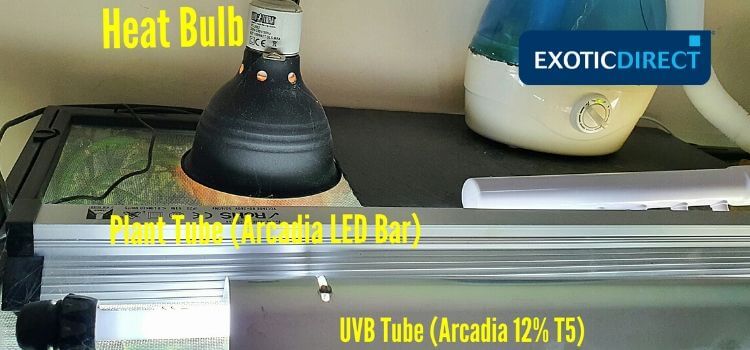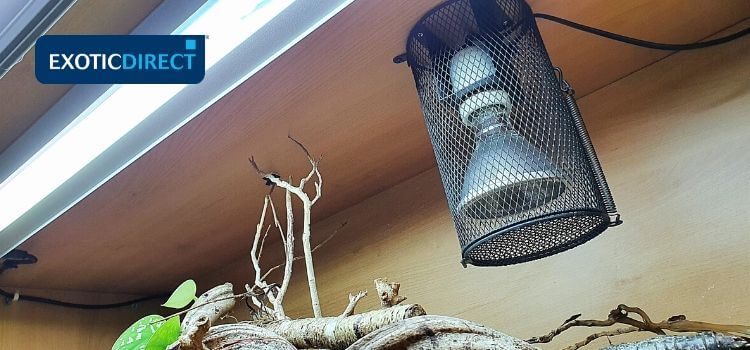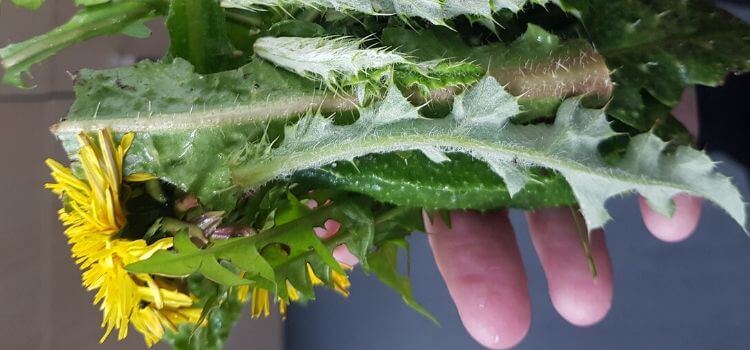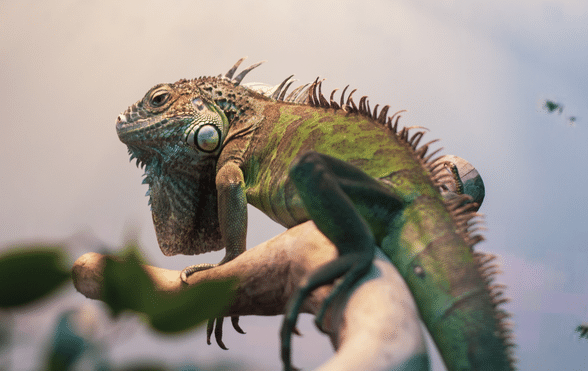How to setup your iguana’s vivarium including vivarium size, lighting, heating, humidity and substrate.
Is your iguana insured? Get a quote for £1,000 of vet fees, death and theft cover. Vet fee cover only also available | We’ve been insuring exotic pets since 1996 | Check out our customer reviews on Feefo.
The Green iguana (Iguana iguana) originates from southern Brazil, Paraguay, Caribbean, Florida, Hawaii and the Virgin Islands.
They are a herbivore arboreal species, meaning the spend most of their time up in a tree canopy and consume mostly vegetation.
Iguana enclosure
Size wise you should go big, it’s as simple as that. You’re going to need a very large enclosure for a Green iguana.
A 6ft high x 6ft length x 2ft depth is the absolute minimum requirements for the species.
Personally, I will always advise bigger, as bigger is better.
With the above in mind, you then need to make good use of that setup and its usable surface area.
Simply adding a number of large branches and shelves diagonally in the setup will increase that usable surface, giving you 30 – 40ft usable space, plus. This allows more physical enrichment for the iguana as well as a better thermo-regulatory gradient for it to use.
Also, the use of a large garden trellis for the background adds not only an option for traversal in the setup, but you can cover this with foliage. This will help it to look more attractive and less bare.
Safe paint for an iguana enclosure
No paint is safe for an iguana enclosure. Fumes and heat become an issue depending on paint choice made. The only thing I’d use to seal wood would be epoxy or yacht varnish.
Baby iguana setup | Green iguana heat | Heat at night | Iguana humidity | UVB requirements for an iguana | Plant growth specific lighting | Safe plants and branches | The Fiji iguana | The Desert iguana
Baby iguana set up
For a young iguana enclosure a 4ft high x 2ft length x 2ft depth will work, but it’s not going to last long at all. Once a year old plus, it’s going to be demanding space. So it’s still worth going straight into a forever home.
Providing plenty of coverage options for the animal to feel safe if needed is always something you should provide at any age but would be more utilised when it’s a youngster.
The temperature and UVB requirements of a baby are the same as a juvenile and adult Green iguana.

One of Pete’s setups showing a heat bulb, plant tube and UVB tube
Green iguana heat
You are aiming to achieve a basking air temperature of around 37 – 40 degrees Celsius at the top of the enclosure, and ideally a low 20 degrees Celsius in the bottom half.
This gives an optimal heat gradient and aids utilisation of the whole enclosure, providing exercise.

Do iguanas need heat lamps?
Yes they do, and the bulb type should be a nice bright white halogen flood bulb. You need to be heating as much of the iguana as possible, and a ‘spot’ bulb wouldn’t achieve this. A flood type bulb has a much wider beam spread.
Many keepers will use two basking floods next to each other in order to achieve this heat coverage on the iguana. This is the same for any species that utilise a basking area. So doing such may mean you need two lower wattage bulbs to achieve the needed temperatures.
The wattage you need is dependent on geographical location, set up location in the home and room temperature.
Try purchasing a number of wattage’s to see what combination works best.
Using a Dimming thermostat will also help achieve a suitable basking temperature, in a safe more precise way.
Heating pad
You won’t need a heat pad or mat for an iguana as it’s of no use to it in such a large enclosure.
Heat rocks
Iguana’s don’t need heat rocks as they wouldn’t utilise one at all. They prefer to be up in the foliage and branches.
Do iguanas need a heat lamp at night?
No, this is simply not needed at all. Your iguana will benefit from a good temperature drop over night.
If the enclosure does get below, say, 16 degrees Celsius, then the use of a Ceramic bulb (CHE) or the Arcadia Deep Heat Projector to keep the temperatures around 18 – 20 degrees Celsius is fine. But honestly, don’t worry about night temps. They have evolved to utilise a good temperature drop. So ALL light and heat off at night. No coloured bulb, nothing 🙂
Mercury Vapour Bulbs
I know many keepers that use these “all-in-one” bulbs, but I would only advise under a few conditions.
Due to them emitting both UVA and UVB as opposed to a standard bulb just providing UVA, they can not be run through a thermostat. This means you have zero safety protection to stop overheating within your setup. If you do use you must use a safety cage.
Also, they post a risk regarding UVB exposure so you’ll need a Solar-meter 6.5 to read the UV-Index being emitted. Without this, you could mount it at a dangerous distance, leading to thermal burns and photo-kerato conjunctivitis. Not good.
For these reasons, I’d recommend sticking with a separate heat and UVB tube.
Iguana humidity
You should try to aim for around 70% humidity.
This is best achieved with the use of real foliage, moss and a good soil substrate. And the use of an automatic misting system. MistKing are the best.
Of course, manual misting via a hand sprayer is adequate, but if you have a very territorial iguana you’ll not be wanting to put your hand in the setup. Automated systems work best, misting around 2 or 3 times a day.
Also, something like a humidifier is great for a humidity boost. It’s best to run it via a plug timer for a couple of minutes 2 or 3 times a day.
The difference between this and a misting system, is that a misting system sprays water. This is far more effective in a larger setup.
Something like the MistKing has its own timer. If your misting system doesn’t have this, I’d use a plug timer.
You should let it spray for 10 or 30 seconds a couple of times a day.
The need for spraying and/or fogging will vary though, as its very much dependent on the setup used, and the ventilation and decor etc.
The more foliage, branches and substrate the better humidity is maintained, thus requiring less spray time.
UVB requirements for an iguana
According to the study made by a team from the Texas Christian University, led by Professor Gary Ferguson, Green iguanas require a UV-Index of 2.9 to 7.4 in their basking zone (Ferguson zone 3/4).
To achieve this, you’ll be wanting the largest Arcadia T5 12% (46”/54w), at a distance of around 13 -15 inches from the reflected tube to iguana’s back at the closest point. Remember, this must be reflected.
The new Arcadia ProT5 kits would be ideal as this includes all that is needed. Northampton Reptile Centre stock these.
With a large setup, a couple of UVB bulbs may be required to UV expose larger areas.
Plant growth specific lighting
I fully recommend the Arcadia Jungle Dawn LED Bar. I use these myself, and have an install and tech video available on YouTube.
Plant specific lighting in a setup where real foliage, plant, flowers and such are being used is extremely beneficial.
Not only do they produce the 6.2 kelvin light range, thought to be the natural range emitted from the sun that plants utilise but they add to the full spectrum of light that will only benefit the iguana.
As with most reptiles, birds and fish, iguanas have far better vision that our own, so adding to such adds more visual and mental stimulation within the set up.
In case you’re concerned that you’re providing too much light with the 3 suggested lights – halogen for heat, UVB tube and plant growth tube – you’re not. These add to the full spectrum of lighting to which reptiles utilise. And allow for a more natural light spectrum within the setup.

Safe plants include dandelion although don’t pick from the roadside and wash well before you give to your iguana
Safe plants and branches for an iguana set up
Whether to use real or fake is a very debatable subject. But with a species that is a herbivore/frugivore, using real plants, branches and leaves for it to graze and forage on, is vital. Learn more about what iguanas eat in my dedicated article.
Edible branches:
Ash, hazel, willow and hawthorn branches with the leaves attached are great examples of safe and edible leaves widely available here in the UK.
Edible plants and flowers:
As for plants and flowers. The list is almost endless.
Fuchsia, Nasturtium, Petunia, Pansies, Viola and Grape Vine, are all examples of safe options to use within the enclosure. Iguanas will eat these, which is great, so don’t expect them to last long.
Fake plants and vines are fine. But there is a risk of them being ingested. This can result in hefty vet bills.
That’s not to say don’t use them. I’ve used them with many species, many times over the years, without any related issue. But I do know keepers that have had issues. So it’s your choice.
I would recommend sticking to the reptile specific branded fake plants and vines. These have been tested to withstand the conditions within a setup. Unlike the ones you can get off eBay, or in pound shops for example. These are a risk for multiple reasons. They are can be a fire hazard, poorly made and with dangerous materials.
Toxic plants:
This is another minefield subject, as some say something is safe. Others, the complete opposite.
I suggest picking a list online, and sticking with it. One of the best lists I found was this one via Reptiles Magazine.
Best substrate for iguanas
Bioactive setup
As you’ll know from my previous articles, for any species, I love a natural topsoil based substrate, with the added ‘cleaner’ bugs to aid the breakdown of faeces naturally.
This is commonly known as a ‘bioactive’ setup. And most reptile stores online will have a host of supplies, cleaner bugs included (Northampton Reptile Centre, for example).
This would involve a play-sand and topsoil mix, with a ratio of around 70/30 in favour of the topsoil.
Add some moss and leaf litter, and of course the cleaner bugs, and you’ll have a fully functional bioactive eco-system. This in-turn will keep plants alive.
It’ll also provide natural smells and humidity, and you’ll rarely have to clean-up the iguana waste, as the bugs will take care of it. But if you do see any waste, clean it up anyway. This is best practice.
Of course, you don’t even have to add the cleaner bugs. Just do the above without adding them. But you’ll be required to be more vigilant with the waste inspections.
Another popular method is just pond liner or bare floor. This does make cleaning super easy. The choice is yours.
But do bear in mind, the Green iguana will spend 99% of its time off the floor in the canopy you’ve created in a captive environment. Only really venturing down to graze on flowers and weeds or if female, to lay eggs.
The Fiji iguana
There are other iguana available in the hobby today.
The Fiji iguana (Brachylophus fasiatus) is getting far more popular. Originating as per the name, from the south pacific of Fiji, Tonga and Vanuatu.
The Fiji iguana is often thought to be omnivorous, meaning it will eat plants, flowers, weeds and insects. Unlike its vegetation only eating Green iguana cousins.
But research by Dr John Iverson, whom performed gut morphology on many iguana species to determine just what their digestive tracts are adapted for, has concluded that they should in-fact be classed as herbivore. Just as their green iguana cousins.
The setup requirements I’d honestly keep the same as for the Green iguana.
The Desert iguana
The Desert iguana (Dipsosaurus dorsalis) is also another increasingly popular iguana in captivity. A species found around the south-west of the United States and Northwest Mexico.
Although this species is the smaller of the above fore-mentioned, I’d again still recommend the same requirements for setup size, although you could get away with a 4ft high x3ft length x 2ft depth for this smaller species.
But again, bigger is always better. Heat, temperatures and uvb are the same as already mentioned.
The Desert iguana are primarily vegetation eating like the Green iguana, but will consume the odd insect in the wild. So offering them on occasion in captivity would mimic this requirement. But main diet of vegetation is needed.
Please keep an eye on my blog www.reptilenetworks.co.uk for more on the science, tech, collective knowledge, videos, and blogs on the advancement of keeping of our reptiles and amphibians.
Is your iguana insured? Get a quote for £1,000 of vet fees, death and theft cover. Vet fee cover only also available | We’ve been insuring exotic pets since 1996 | Check out our customer reviews on Feefo.

